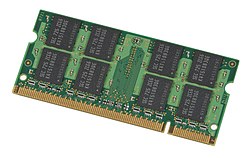Characteristics of storage

Storage technologies at all levels of the storage hierarchy can be differentiated by evaluating certain core characteristics as well as measuring characteristics specific to a particular implementation. These core characteristics are volatility, mutability, accessibility, and addressability. For any particular implementation of any storage technology, the characteristics worth measuring are capacity and performance.
Volatilityedit
Non-volatile memory retains the stored information even if not constantly supplied with electric power. It is suitable for long-term storage of information. Volatile memory requires constant power to maintain the stored information. The fastest memory technologies are volatile ones, although that is not a universal rule. Since the primary storage is required to be very fast, it predominantly uses volatile memory.
Dynamic random-access memory is a form of volatile memory that also requires the stored information to be periodically reread and rewritten, or refreshed, otherwise it would vanish. Static random-access memory is a form of volatile memory similar to DRAM with the exception that it never needs to be refreshed as long as power is applied; it loses its content when the power supply is lost.
An uninterruptible power supply (UPS) can be used to give a computer a brief window of time to move information from primary volatile storage into non-volatile storage before the batteries are exhausted. Some systems, for example EMC Symmetrix, have integrated batteries that maintain volatile storage for several minutes.
Mutabilityedit
- Read/write storage or mutable storage
- Allows information to be overwritten at any time. A computer without some amount of read/write storage for primary storage purposes would be useless for many tasks. Modern computers typically use read/write storage also for secondary storage.
- Slow write, fast read storage
- Read/write storage which allows information to be overwritten multiple times, but with the write operation being much slower than the read operation. Examples include CD-RW and SSD.
- Write once storage
- Write Once Read Many (WORM) allows the information to be written only once at some point after manufacture. Examples include semiconductor programmable read-only memory and CD-R.
- Read only storage
- Retains the information stored at the time of manufacture. Examples include mask ROM ICs and CD-ROM.
Accessibilityedit
- Random access
- Any location in storage can be accessed at any moment in approximately the same amount of time. Such characteristic is well suited for primary and secondary storage. Most semiconductor memories and disk drives provide random access.
- Sequential access
- The accessing of pieces of information will be in a serial order, one after the other; therefore the time to access a particular piece of information depends upon which piece of information was last accessed. Such characteristic is typical of off-line storage.
Addressabilityedit
- Location-addressable
- Each individually accessible unit of information in storage is selected with its numerical memory address. In modern computers, location-addressable storage usually limits to primary storage, accessed internally by computer programs, since location-addressability is very efficient, but burdensome for humans.
- File addressable
- Information is divided into files of variable length, and a particular file is selected with human-readable directory and file names. The underlying device is still location-addressable, but the operating system of a computer provides the file system abstraction to make the operation more understandable. In modern computers, secondary, tertiary and off-line storage use file systems.
- Content-addressable
- Each individually accessible unit of information is selected based on the basis of (part of) the contents stored there. Content-addressable storage can be implemented using software (computer program) or hardware (computer device), with hardware being faster but more expensive option. Hardware content addressable memory is often used in a computer's CPU cache.
Capacityedit
- Raw capacity
- The total amount of stored information that a storage device or medium can hold. It is expressed as a quantity of bits or bytes (e.g. 10.4 megabytes).
- Memory storage density
- The compactness of stored information. It is the storage capacity of a medium divided with a unit of length, area or volume (e.g. 1.2 megabytes per square inch).
Performanceedit
- Latency
- The time it takes to access a particular location in storage. The relevant unit of measurement is typically nanosecond for primary storage, millisecond for secondary storage, and second for tertiary storage. It may make sense to separate read latency and write latency (especially for non-volatile memory) and in case of sequential access storage, minimum, maximum and average latency.
- Throughput
- The rate at which information can be read from or written to the storage. In computer data storage, throughput is usually expressed in terms of megabytes per second (MB/s), though bit rate may also be used. As with latency, read rate and write rate may need to be differentiated. Also accessing media sequentially, as opposed to randomly, typically yields maximum throughput.
- Granularity
- The size of the largest "chunk" of data that can be efficiently accessed as a single unit, e.g. without introducing additional latency.
- Reliability
- The probability of spontaneous bit value change under various conditions, or overall failure rate.
Utilities such as hdparm and sar can be used to measure IO performance in Linux.
Energy useedit
- Storage devices that reduce fan usage, automatically shut-down during inactivity, and low power hard drives can reduce energy consumption by 90 percent.
- 2.5-inch hard disk drives often consume less power than larger ones. Low capacity solid-state drives have no moving parts and consume less power than hard disks. Also, memory may use more power than hard disks. Large caches, which are used to avoid hitting the memory wall, may also consume a large amount of power.
Securityedit
Full disk encryption, volume and virtual disk encryption, andor file/folder encryption is readily available for most storage devices.
Hardware memory encryption is available in Intel Architecture, supporting Total Memory Encryption (TME) and page granular memory encryption with multiple keys (MKTME). and in SPARC M7 generation since October 2015.
Comments
Post a Comment